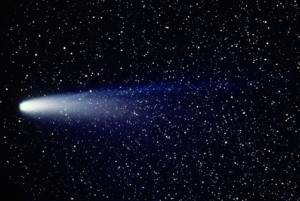Dragons and Hairy Stars in Early Ireland September 30, 2010
Author: Beach Combing | in : Medieval , trackback Beachcombing knows that there is a fashion for exaggerating the achievements of the medieval Irish. So let Beachcombing be emphatic. The early Irish did not have a table of elements. They did not talk of words like ‘relativity’ or ‘displacement’. They did not make clones or drop atom bombs. However, recent research has suggested that in astronomy they excelled.
Beachcombing knows that there is a fashion for exaggerating the achievements of the medieval Irish. So let Beachcombing be emphatic. The early Irish did not have a table of elements. They did not talk of words like ‘relativity’ or ‘displacement’. They did not make clones or drop atom bombs. However, recent research has suggested that in astronomy they excelled.
Anyone who has ever read a medieval Irish text will not be surprised to learn this. Early medieval Irish writers radiate the kind of curiosity that one needs to invent or discover. And, from the seventh century, when we have enough writing to make balanced judgements about Irish culture, we have evidence of this energy. For example, Cummian’s Paschal Letter: a dazzling mix of mathematics, calendar studies and insults. Or Concerning the Miracles of the Holy Bible, a work of Biblical exegesis that mentions in passing that Irish monks measured waves to understand the tides better.
However, until very recently the evidence for astronomical studies in Ireland was almost non-existent. Indeed, as recently as 1996 one expert could claim that the Irish knew far less than their neighbours on the Continent about the workings of the heavens.
That this idea has now been turned round is thanks largely to the work of two Irish scholars: Daniel McCarthy and Aidan Breen. In a number of seminal studies McCarthy and Breen have shown that not only did the Irish observe the heavens, but that they did so systematically in a way that cannot be paralleled anywhere else in the Europe of their day.
So why did we have to wait so long to learn about the Irish achievement in astronomy? One important reason is that the Irish did not use the same words to describe the phenomena that they saw. Take the ‘dragons’ that are said to have appeared in Irish skies in 735 ( in fact, a very strong Aurora Borealis). Or the ‘red tower of flame’ reported in 1054 (a supernova). Or, charmingly, ‘the hairy star’ (Haley’s Comet) in 1066.
McCarthy and Breen decoded these entries and others like them using contemporary reports from around the world and complicated scientific formulae. So we have, for example, the Super Nova of 1054 – an eruption in the Crab Nebula (MI). Evidence from China for that same year talks of a ‘reddish-white’ star ‘with pointed rays that shone from all sides’. And McCarthy and Breen rolled out the hardware to show that these ‘pointed rays’ would also have been visible in Ireland. In terms that neither Beachcombing nor the medieval Irish would have understood: ‘If f(ρ) = 105.36 [1.06+cos2ρ]+ 10 (6.15 – ρ/40) + 6.2 x 107 x (ρ) –2 then mth = 8.88 + k (sec z sun – sec Z ) – 2.5 x log [f(ρ) x (1-10 –0.4kxsec z)]’
‘But so what!’, the reader might say. This hardly adds up to evidence for scientific knowledge. After all, you do not have to be a genius to stop and point in amazement at something unexpected in the sky and call it a ‘dragon’ or a ‘burning tower’.
Beachcombing concedes the point. But these entries were only, in fact, the tip of the iceberg, a select few recorded for posterity. The Irish took the trouble to put them into their chronicles – the annals of Ireland – because they were thought to be omens of the end of the world. The super nova (‘tower of flame’), for example, was treated with special awe because it appeared on the day of St George: the slayer of the dragon of the antichrist in Irish tradition.
Yet, even if these entries were not written into Irish annals for scientific reasons, they do, anyway, betray scientific attitudes and scientific knowledge. First, look at the details given. For example, in the year 672 ‘a thin and tremulous cloud in the shape of a rainbow appeared at the fourth vigil of the night on the sixth feria preceding Easter, from east to west through a clear sky.’ Precision in timing and observation were obviously valued.
Then, second, many of the events described were actually not so dramatic: for example, low magnitude lunar and solar eclipses in 688 and 691. Breen and McCarthy believe that the lunar eclipses suppose people sitting up and watching the skies deliberately; otherwise it is unlikely that they would have been noticed at all.
We only know about the Irish achievement in astronomy because, by great good fortune, a few observations did get sucked into these annals and so survived.
But what else did the Irish study or discover that never got written down in one of those few, great, bound manuscripts that have reached the modern age? Drbeachcombing AT yahoo DOT com


